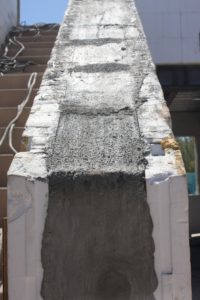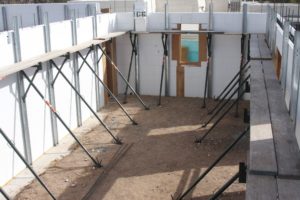Sound And Vibration
All sound is created by vibrations. Sound vibrations must have a medium to travel in. The most popular and familiar medium is air and we hear those sound vibrations everyday through air. Air does a reasonable job of transmitting sound vibrations because it has low mass and can transmit sound energy over a wide band of frequencies.
Air Travel
Air is a good medium for low frequencies but less effective at higher frequencies. When you are farther away from a loudspeaker, you will notice that the high frequencies are less pronounced or in audio jargon, rolled off. If you go to a live performance and you do not like piercing highs coming at you at large pressure levels, sit farther back. If you are trying to get the attention of your friends to help direct them to your seating area and you call out their names from far away, the same muffled high frequency effect occurs.
Room Mass
Your room whether it is a listening room, home theater room, or professional recording studio will have objects within it that have much more mass than air does. This increased mass of these objects will be less effective at transmitting shorter wavelengths namely high frequency energy. When you hear the stereo or band playing in the next room or adjoining structure, one usually “hears” the lower frequencies because they are transmitted through the structure more easily than higher frequencies. With these examples in mind, lets formulate a few guidelines:
1. Soundproofing is really about lower frequencies.
2. All sound that is transmitted needs a medium to move through and that medium must be continuous.
3. In our audio rooms the medium will be a solid structure with mass such as drywall, wood, or concrete.
Sound Pathways
Lets look at a sound wave as it leaves our neighbor’s stereo system. When the frequencies strike our wall surface, some of the energy is reflected back to the source and some of the energy goes through the wall itself. This is the point where people usually get confused about sound treatment and sound proofing. If we are trying to keep the sound energy within the room, then the room’s reverberation times will increase and we need to use acoustical treatment within the room. The sound energy that escapes our room, will not add to our room’s reverberation signature, but will annoy all individuals in adjacent structures. This is where soundproofing comes in.
Hard Surfaces
The hard surface of our walls is a partial explanation for this phenomenon. It is the hardness of the wall’s surface, but the composition of the wall itself. The wall has increased mass over air and this increased mass is like your car hitting a brick wall abruptly. The air is what we term to be compliant and the wall is much less compliant. This wide level of density changes from air to a solid wall changes the transfer of energy ratio. Thus, only a fraction of the energy that was in the air to start with will penetrate the wall itself. This is why our homes are quieter when all the doors and windows are closed.
Energy Not Lost
The energy that does not penetrate our walls must also be looked at and examined. We know from the laws of physics that the energy can not simply vanish. This comes from the First Law of Thermodynamics which states that energy is neither created or destroyed. Since there is nothing to absorb the energy, it will only be reflected back. If we place what the literature calls “acoustic tile” on the wall, we now have a situation that the tile is denser than the air but obviously not as dense as dry wall. This offers us a change in density. Tracing the sound transmission path, we have air to tile and tile to wall. Therefore, less energy will reflect back and some of our higher frequency, air borne, energy will be absorbed. However, more of our lower frequency energy will be transmitted. How do we reduce these transmissions?
Abrupt Mass Change
We know that we need an abrupt change in mass to have an impact on our vibration transmissions and thus sound energy. Lets examine two different structures to illustrate our points. If we take a wall that has two sheets of drywall glued together and nothing in between and a wall with the same two sheets of drywall separated by studs, we have two walls that have the same mass, but the wall separated by the studs will have a higher sound transmission class number holding back more sound energy. The wall with the studs contains more changes in mass or density for our vibrations to travel through.
Common Drywall
In our two pieces of drywall only example, sound energy strikes our wall and then travels quickly through both walls. In our wall with the studs separating the two pieces of drywall, we have an air space between the two pieces of drywall. Incidentally, we can make that structure even more effective by filling the air cavity between the drywall panels with a fibrous material such as mineral wool or fiberglass insulation. That’s because the cavity between the drywall sheets will resonate, and friction of the vibrating air against the fibers will produce heat. We can’t actually destroy the energy, but we can turn it into non-acoustic form.
Lower Frequencies
Either wall structure will work well when we consider lower frequencies. In both of our wall examples, the drywall will have to be nailed to studs for support. It would be great if we could figure out how to have them “float” in space without any attachment points but that is not realistic. The drywall sheets nailed to the studs, will form a solid entity which is a road for lower frequency energy to travel upon. Even though the two walls are different because of the air space, they are both viewed as a solid entity by longer, lower frequency energy.
Sound Mediums
Sound travels through mediums. Air is a medium and so are the physical materials we use to build our home theater, personal listening rooms, and professional recording studios. To soundproof our structures we must use mass that is arranged in a specific manner in order to reduce vibrations. It is the vibrations that produce sound energy and proper structure vibrational management is critical if we are to have any success at the soundproofing task. In part two, we will discuss more on vibration and damping.







